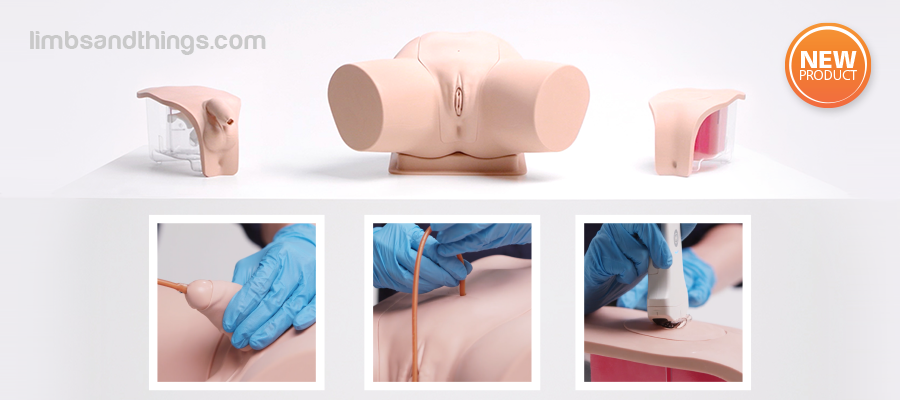How Urinary Catheterization Trainers Can Save 13,000 Patients a Year
Did you know that urinary tract infections are among the most common Healthcare Associated Infections (HAI), accounting for 13,000 deaths each year? Even more concerning, according to the Centers for Disease Control and Prevention approximately 75% of all urinary tract infections are associated with the presence of a urinary catheter! As simulated cath trainers have been shown to improve learner performance for this delicate procedure, it is HealthySimulation.com’s recommendation that every healthcare simulation program immediately consider including urinary catheterization trainers in their curriculum — especially now that a new range from Limbs & Things is available!
About 25% of all hospitalized patients have an indwelling catheter during their stay, and the risk for Catheter-Associated Urinary Tract Infections, or CAUTI, increases with each day the catheter remains in place. CAUTI can cause increased pain and discomfort for the patient, and they can increase the length of the patient’s hospital stay, therefore increasing hospital costs that are not covered by insurance. An Australian study concluded that a patient who had developed CAUTI would, on average, increase their hospital stay by four days. Another study conducted in the United States detailed that, while the cost of treating a case of CAUTI widely depends on ‘population, patient acuity and cost perspective’, it is still expected to exceed a financial output of at least $1000 per patient.
In 2009, R. Douglas Scott II estimated that CAUTI was costing the US healthcare system between $340 million and $450 million, while statistics in the previously referenced study in the United States actually suggests that number is closer to $1.7 billion.
Sponsored Content:
Given that that a large proportion of CAUTI instances can be prevented, the financial cost attributed to treating CAUTI cannot be justified. Aseptic insertion and removal techniques, strict management, and prompt removal of the catheter when no longer needed can aid in lowering the risk of CAUTI.
The urinary catheterization procedure is taught worldwide in many medical settings, including undergraduate medicine, post-graduate medicine, nursing and physician assistant/associate. Despite the importance of urinary catheterisation as a core skill, it is apparent that the proper training does not transfer to proper practice in the clinical setting.
As we know, affordable medical simulation training solutions can standardize training and annual competency of healthcare providers, and in this case, reduce the incidence of CAUTI.
Todsen et al. found in Short- and long-term transfer of urethral catheterization skills from simulation training to performance on patients that “medical students demonstrated good transfer of urinary cath skills learned in the skills lab to real clinical situations up to six weeks after training”. The research team also recommended that “simulated urinary catheter training should be the standard for all medical school curricula to reduce avoidable complications.”
Sponsored Content:
New Catheterization Trainer Range from Limbs & Things
The new Catheterization Trainer Range from Limbs and Things provides a cost-effective and versatile collection of products, enabling teaching and learning of urinary and suprapubic catheterization on both female and male models.
A key feature of the new Limbs & Things urinary catheter range is the anatomically correct transparent pelvic shell, allowing the trainee and instructor to track the progress of the procedure, allowing for real-time feedback, encouraging standardization for skills and competency training.
Equipped with realistic male and female anatomy, the Limbs & Things Catheterization Trainer Range facilitates a realistic feel of catheter insertion supporting these key features:
- Realistic Anatomy:
- Supple urethra and resistant sphincter providing realistic response
- Male anatomy: realistic meatus, flaccid penis, replaceable and removable foreskin
- Soft labia allow trainees to practice parting using aseptic no-touch technique
- Subtle female meatus to simulate a more realistic learning experience
- Presence of vaginal vault allows insertion of catheter in the incorrect location
- Pre-ported suprapubic catheter
- Pubic bone
- Versatility:
- Ability to view catheter path
- Non-drip valve
- Reusable double-sleeve catheter packaging is supplied for teaching aseptic technique
- Syringe supplied with water-based lubricant to simulate proprietary local anaesthetic gel
- Skills Based Learning Includes:
- Correct handling of male and anatomy
- Aseptic catheterization technique
- Withdrawal of catheter
- Urinary catheterization
- Fluid management
- Suprapubic catheter management
The range allows for standardized urinary catheterization training in a controlled environment at an affordable price. Investing in training will provide long-term gains as trainees become better acquainted with the procedure of urinary catheterisation.
Learn More About Limbs & Things Catheterization Trainers!
Sponsored Content:



















